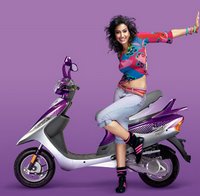Company: Johnson&Johnson
Agency: McCann Ericson
Brand count: 167
Band-Aid can be considered as an classic case of branding success. The brand which is almost 86 year old has become generic to the category. Band-Aid is an Adhesive Bandage us
 ed to cover minor cuts and bruises. The brand has come a long way to become one of the classic marketing case study.
ed to cover minor cuts and bruises. The brand has come a long way to become one of the classic marketing case study.The brand came into existence in 1920. The person behind this innovation was Ms Josphene Dickson, a homemaker and wife of Mr Eric Dickson who was cotton buyer at Johnson & Johnson. Josphene during her daily chores inevitably encounters numerous minor cuts and bruises, wanted an easy solution to cover the cuts to prevent it from worsening while continuing her work. Eric prepared a readymade bandage using cotton and adhesive tape so that Josphene can cut from the readymade bandage and use it when in need. Eric told his boss about the invention and thus the concept took shape of Band-Aid ( source:superbrand.com).In 1924 the world's first machine cut band-aid was marketed and it was a huge success.
In India, Band-Aid was launched in the year 1978. Band-Aid was successful because it identified the need in the households for wound care. But to reach the dominant position in India was not easy. Band-Aid had to fight the tradition rather than the competitors to succeed. Traditionally, Indians prefer not to cover the cuts and bruises because there is a feeling that wounds should be kept open inorder to heal faster. Further, Indian consumers typically used traditional methods to heal wounds. In earlier days most of the households had the bottle of tincture iodine which was considered as the best solution for cuts and bruises. Kids used to hate this because the pain will be excruciating when tincture iodine is applied
 to cuts. Band-Aid comes with red coloured medicine inside ( I think it is Benzalkonium) which resembled Iodine. This had enabled early adoption of this brand and Band-Aid was called " Lal Dhawa Wali Patti" which became the USP . Had the medicine color was not red, Band-Aid would have tough time convincing mothers. The Kids also loved the brand since they were relieved of the pain of Tincture iodine.
to cuts. Band-Aid comes with red coloured medicine inside ( I think it is Benzalkonium) which resembled Iodine. This had enabled early adoption of this brand and Band-Aid was called " Lal Dhawa Wali Patti" which became the USP . Had the medicine color was not red, Band-Aid would have tough time convincing mothers. The Kids also loved the brand since they were relieved of the pain of Tincture iodine.Band-Aid also tried to educate mothers about the possible problems in keeping the wounds open because of dust infections caused by it. This also boosted the brand acceptability. One of the major factors that aided the success of this brand was the distribution strength of J&J. Band-Aid was a mass market product and hence it has to be there at every shop in the market.
Band-Aid was a brand that changed with time and it keenly watched the consumers and tried to identify their needs. The company had valuable consumer insights that created the first water proof band-aid in India. The main weakness for bandages was that it used to come off easily when wet. This prevented the category usage to certain extent. The waterproof band aid made the brand usable in any condition. This innovation catapulted the brand popularity to newer heights. Band Aid focused on the area of application and was clever enough to come out with various size and shapes. This come from the insight that different wounds in different parts of the body needs different shapes. For example, a small cut in the forehead needs a round band-aid .These insights made the brand a market leader in the category with a market share of over 60%.
Johnson& Johnson also saw an opportunity for the brand in the traditional cure for cuts. In India, turmeric is used as a medicine for cuts and blemishes. Band-Aid launched a turmeric variant of the plaster much to the delight of the Indian consumers. The brand was also promoted heavily. Band-Aid was the first in the category to advertise in electronic media. According to Superbrands.org, Band-Aid was the first product endorsement of Sachin Tendulkar.
Initially positioned as a wound care brand, Band-Aid was repositioned as a product that encourages kids to be active. Kids have the innate desire to be active and Band-Aid makes sure that cuts and bruises will not be hinder that desire. The brand also roped in Virendra Sewag as its ambassador during the cricket season.
Band-Aid has been lying low in the media for a while. The brand has already become generic to the category. Being generic has its share of problems also. When the customer uses the brand as a generic name for the category , the retailer can offer him any brand in the category. There are many local players in the market who gain by a brand major becoming generic. Competition is also from players like Handyplast and Dettol. Although the Indian wound care market is estimated to be around Rs 512 crore, the domestic adhesive bandage category is small at Rs 25 crore. The brand equity of Band-Aid still going strong is a an entry barrier for any one looking to enter this category.
The brand is currently being positioned on " Continuous Care". The positioning is pitting this brand against the ointments and other external applications. The concept is to educate the customers that use of plasters will heal wounds better than the use of ointments.
source: superbrands.com,jandjindia.com,agencyfaqs











